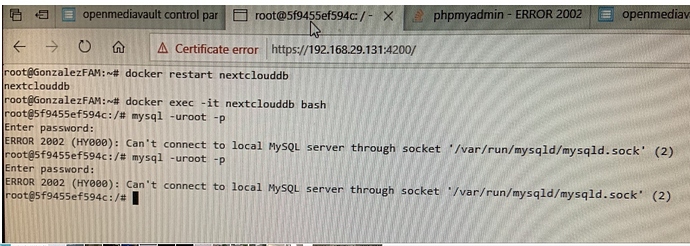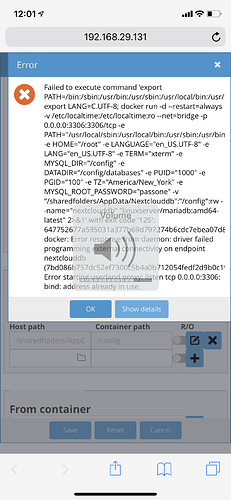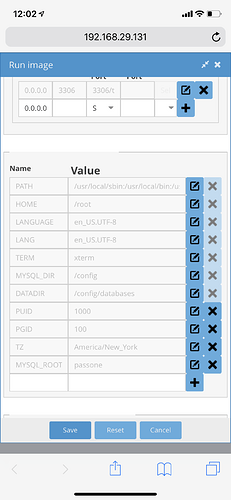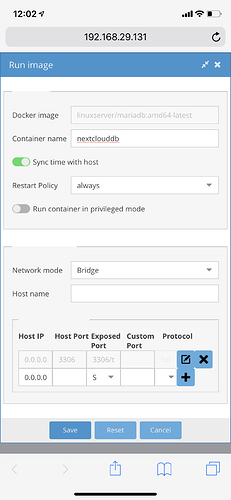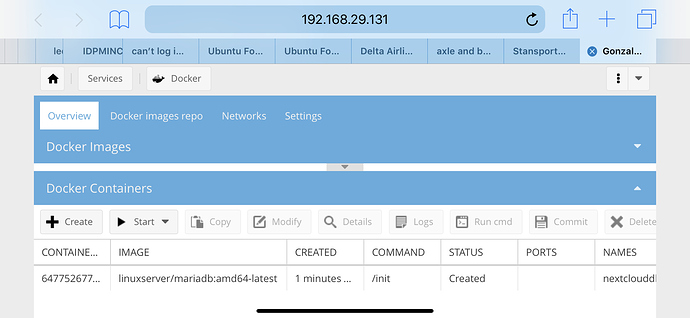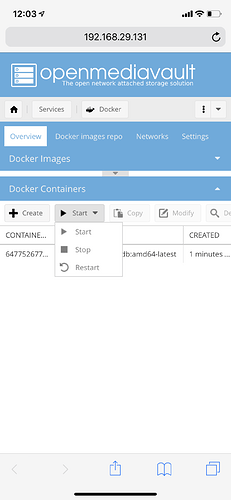I am trying to install Nextcloud on open media vault using technodad live I was able to get trough till when I need to log in to MySQL it does not let me log in. Tried reinstalling it but still get the same problem frustrated don’t know what to do please help.
You are executing the mysql command without parsing the socket path so that a default value is used from the configuration file.
Does the socket exist on your server?
If not, what is the correct path to the socket?
You can try to find this out by checking the parameters used by the service, e.g. ps -ef | grep mysqld or by checking the MySQL configuration file, like e.g. # grep "sock" /etc/mysql/my102.cnf.
You appear to be running MySQL in a docker container, getting on the container’s console, and attempting a socket connection from inside the container. Is that correct? This is not the type of connection Nextcloud would be using when running in docker.
When you run Nextcloud in docker, Nextcloud and the database will be in separate containers, and you’ll need to use a TCP connection between them. If you could show me how you have your containers set up I may be able to offer a suggestion.
So I had deleted the container to see if creating a new one will fix the problem then I get an error.
I also took pictures of other things to see if you guys can see if there is anything I did wrong.
Thanks in advance
!Well again I don’t think a socket connection is what you need. You have TCP port 3306 exposed on the container. Nextcloud needs to connect to that exposed port, not to a socket. So on the mysql command you would also need to provide I think -h localhost.
Kind of new at it so is it ok if you can give me a little more detail? Sorry to be a pain just really want to get this to work. I got a little frustrated so I reinstalled OMV and finally was able to get through the error of creating the container now I am left with another error when trying to sign on the MySQL. Please help. Thanks again In Advance
I’m still wondering why you are trying to get into MySQL on the container. This is entirely unnecessary in most cases. Let’s take a step back and understand what needs to be taking place here.
So if you’re running this in Docker you will have a Nextcloud container and a database container such as MariaDB. You set the root password as described on the Docker Hub page.
If the two are in the same Docker network, you can use the container name as the hostname for Nextcloud to connect to. Otherwise you expose the TCP port on the Docker host and have Nextcloud connect to that. And then you also provide the MySQL root login. Nextcloud takes care of the rest itself and creates the database it needs.
@Anthony_Gonzalez
normally you don’t use a root user/password.

use MYSQL_USER and MYSQL_PASSWORD instead.

and don’t expose port 3306 to the outside world. ![]()
Hi thanks for the quick response the thing is that I was following this video by technodad in YouTube Nextcloud OMV and that is one of the steps.
So I finally got to install it successfully only problem now is that when I am in the create user and password when I hit finish it times me out 504 don’t know what am doing wrong.
is the user created anyway?
did you provide the users email when you create one? and did you setup email correct?
once you try to create a user with email nextctloud wants to send a welcome email.
This is the error I get don’t know what to do.

If structure is missing from your database schema, I’m going to suggest you scrap it and start over.
Create brand new containers of Nextcloud and MariaDB. Provide all the setup info via environment variables as per the respective documentation for each Docker image. As long as they are on the same Docker bridge, you use the container name as the address for them to connect to each other, and no ports need to be exposed. Just expose the port for Nextcloud itself.
If you do all that, you should be able to connect into an already configured Nextcloud system and skip the setup wizard entirely.
